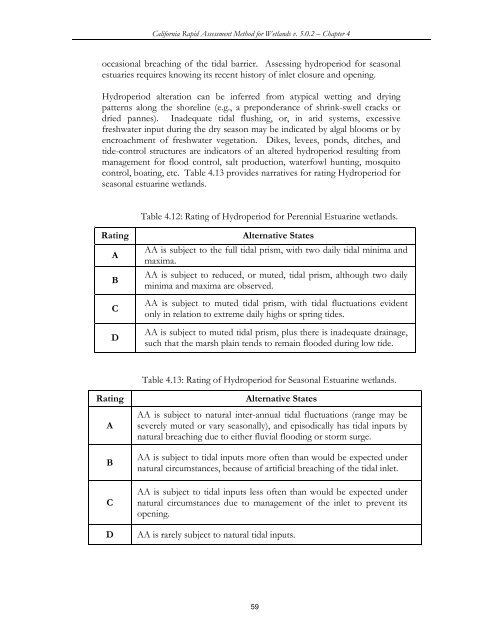(CRAM) For Wetlands User's Manual Version 5.0.2
(CRAM) For Wetlands User's Manual Version 5.0.2
(CRAM) For Wetlands User's Manual Version 5.0.2
You also want an ePaper? Increase the reach of your titles
YUMPU automatically turns print PDFs into web optimized ePapers that Google loves.
California Rapid Assessment Method for <strong>Wetlands</strong> v. <strong>5.0.2</strong> – Chapter 4<br />
occasional breaching of the tidal barrier. Assessing hydroperiod for seasonal<br />
estuaries requires knowing its recent history of inlet closure and opening.<br />
Hydroperiod alteration can be inferred from atypical wetting and drying<br />
patterns along the shoreline (e.g., a preponderance of shrink-swell cracks or<br />
dried pannes). Inadequate tidal flushing, or, in arid systems, excessive<br />
freshwater input during the dry season may be indicated by algal blooms or by<br />
encroachment of freshwater vegetation. Dikes, levees, ponds, ditches, and<br />
tide-control structures are indicators of an altered hydroperiod resulting from<br />
management for flood control, salt production, waterfowl hunting, mosquito<br />
control, boating, etc. Table 4.13 provides narratives for rating Hydroperiod for<br />
seasonal estuarine wetlands.<br />
Table 4.12: Rating of Hydroperiod for Perennial Estuarine wetlands.<br />
Rating Alternative States<br />
AA is subject to the full tidal prism, with two daily tidal minima and<br />
A<br />
maxima.<br />
AA is subject to reduced, or muted, tidal prism, although two daily<br />
B<br />
minima and maxima are observed.<br />
C<br />
D<br />
AA is subject to muted tidal prism, with tidal fluctuations evident<br />
only in relation to extreme daily highs or spring tides.<br />
AA is subject to muted tidal prism, plus there is inadequate drainage,<br />
such that the marsh plain tends to remain flooded during low tide.<br />
Table 4.13: Rating of Hydroperiod for Seasonal Estuarine wetlands.<br />
Rating Alternative States<br />
A<br />
B<br />
C<br />
AA is subject to natural inter-annual tidal fluctuations (range may be<br />
severely muted or vary seasonally), and episodically has tidal inputs by<br />
natural breaching due to either fluvial flooding or storm surge.<br />
AA is subject to tidal inputs more often than would be expected under<br />
natural circumstances, because of artificial breaching of the tidal inlet.<br />
AA is subject to tidal inputs less often than would be expected under<br />
natural circumstances due to management of the inlet to prevent its<br />
opening.<br />
D AA is rarely subject to natural tidal inputs.<br />
59















